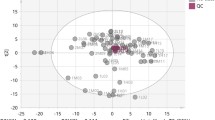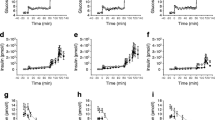Abstract
Excess cortisol and GH induce insulin resistance, a central feature of type 2 diabetes (T2D). To study whether the insulin sensitizer pioglitazone affects basal cortisol levels and the GH–IGF-I axis in patients with T2D. Forty-eight patients with T2D (men/women = 28:20, age 61 ± 1 years, BMI 31 ± 0.6 kg/m2) were treated for 26 weeks with pioglitazone 30–45 mg daily in addition to their preexisting therapy. Insulin, proinsulin, HbA1c, IGF-I, IGFBP-1, and basal cortisol were analyzed before and after treatment. Pioglitazone decreased proinsulin/insulin ratio and HbA1c decreased (HbA1c from 7.8 ± 0.2 to 6.6 ± 0.2 % in men and from 7.6 ± 0.2 to 6.1 ± 0.2 % in women, p < 0.001 in both). There was a redistribution of fat but no change in waist circumference. IGF-I and adiponectin increased (p ≤ 0.001) in both genders. IGFBP-1 increased but significantly only for the whole group (p = 0.033). Triglycerides decreased significantly in women only (p = 0.015). Before treatment, women had lower basal cortisol (p = 0.045). Basal cortisol increased in women (from 390 ± 26 to 484 ± 32 nmol/L, p = 0.020) but not in men and did not differ between genders at week 26. ΔIGFBP-1 correlated with Δcortisol (r = 0.458; p = 0.049) and Δadiponectin (r = 0.600; p = 0.005) in women only. In addition to the known effect of improving insulin sensitivity, pioglitazone increased IGF-I regardless of gender and in women also increased basal cortisol. Increased IGF-I may contribute to improved insulin sensitivity after treatment. There seems to be gender differences in treatment responses to pioglitazone on lipid metabolism and basal cortisol, perhaps correcting different mechanisms of insulin resistance between genders.

Similar content being viewed by others
References
Stumvoll M, Gerich J (2001) Clinical features of insulin resistance and beta cell dysfunction and the relationship to type 2 diabetes. Clin Lab Med 21:31–51
Bjorntorp P, Holm G, Rosmond R (1999) Hypothalamic arousal, insulin resistance and Type 2 diabetes mellitus. Diabet Med 16:373–383
Barrett-Connor E (1997) Sex differences in coronary heart disease: why are women so superior? The 1995 Ancel Keys Lecture. Circulation 95:252–264
Rajpathak SN, Gunter MJ, Wylie-Rosett J et al (2009) The role of insulin-like growth factor-I and its binding proteins in glucose homeostasis and type 2 diabetes. Diabetes Metab Res Rev 25:3–12
Moller N, Vendelbo MH, Kampmann U et al (2009) Growth hormone and protein metabolism. Clin Nutr 28:597–603
Baxter RC (1997) Insulin-like growth factor (IGF) binding proteins: the role of serum IGFBPs in regulating IGF availability. Acta paediatr Scand Suppl 372:107–114; discussion 115
Young SCJ, Miles MV, Clemmons DR (1992) Determination of the pharmacokinetic profiles of insulin-like growth factor binding proteins-1 and -2 in rats. Endocrinology 131:1867–1873
Wheatcroft SB, Kearney MT (2009) IGF-dependent and IGF-independent actions of IGF-binding protein-1 and -2: implications for metabolic homeostasis. Trends Endocrinol Metab 20:153–162
Kotronen A, Lewitt M, Hall K et al (2008) Insulin-like growth factor binding protein 1 as a novel specific marker of hepatic insulin sensitivity. J Clin Endocrinol Metab 93:4867–4872
Brismar K, Gutniak M, Povoa G et al (1988) Insulin regulates the 35 kDa IGF binding protein in patients with diabetes mellitus. J Endocrinol Invest 11:599–602
Heald AH, Cruickshank JK, Riste LK et al (2001) Close relation of fasting insulin-like growth factor binding protein-1 (IGFBP-1) with glucose tolerance and cardiovascular risk in two populations. Diabetologia 44:333–339
Ferris HA, Kahn CR (2012) New mechanisms of glucocorticoid-induced insulin resistance: make no bones about it. J Clin Invest 122:3854–3857
Wake DJ, Stimson RH, Tan GD et al (2007) Effects of peroxisome proliferator-activated receptor-(alpha) and -(gamma) agonists on 11(beta)-hydroxysteroid dehydrogenase type 1 in subcutaneous adipose tissue in men. J Clin Endocrinol Metab 92:1848–1856
Yki-Jarvinen H (2004) Thiazolidinediones. N Engl J Med 351:1106–1118+1158
Heaney AP, Fernando M, Yong WH, Melmed S (2002) Functional PPAR-(gamma) receptor is a novel therapeutic target for ACTH-secreting pituitary adenomas. Nat Med 8:1281–1287
Dorkhan M, Magnusson M, Frid A et al (2006) Glycaemic and nonglycaemic effects of pioglitazone in triple oral therapy of patients with type 2 diabetes. J Intern Med 260:125–133
Bang P, Eriksson U, Sara V et al (1991) Comparison of acid ethanol extraction and acid gel filtration prior to IGF-I and IGF-II radioimmunoassays: improvement of determinations in acid ethanol extracts by the use of truncated IGF-I as radioligand. Acta Endocrinol 124:620–629
Hilding A, Brismar K, Degerblad M et al (1995) Altered relation between circulating levels of insulin-like growth factor- binding protein-1 and insulin in growth hormone-deficient patients and insulin-dependent diabetic patients compared to that in healthy subjects. J Clin Endocrinol Metab 80:2646–2652
Povoa G, Roovete A, Hall K (1984) Cross-reaction of serum somatomedin-binding protein in a radioimmunoassay developed for somatomedin-binding protein isolated from human amniotic fluid. Acta Endocrinol 107:563–570
Soderberg S, Ahren B, Eliasson M et al (2001) Circulating IGF binding protein-1 is inversely associated with leptin in non-obese men and obese postmenopausal women. Eur J Endocrinol 144:283–290
Hellenius MLB, Brismar KE, Berglund BH, De Faire UH (1995) Effects on glucose tolerance, insulin secretion, insulin-like growth factor 1 and its binding protein, IGFBP-1, in a randomized controlled diet and exercise study in healthy, middle-aged men. J Intern Med 238:121–130
Sesti G, Sciacqua A, Cardellini M et al (2005) Plasma concentration of IGF-I is independently associated with insulin sensitivity in subjects with different degrees of glucose tolerance. Diabetes Care 28:120–125
Glintborg D, Hermann AP, Hagen C et al (2009) A randomized placebo-controlled study on the effects of pioglitazone on cortisol metabolism in polycystic ovary syndrome. Fertil Steril 91:842–850
Weyer C, Funahashi T, Tanaka S et al (2001) Hypoadiponectinemia in obesity and type 2 diabetes: close association with insulin resistance and hyperinsulinemia. J Clin Endocrinol Metab 86:1930–1935
Sesti G, Federici M, Lauro D et al (2001) Molecular mechanism of insulin resistance in type 2 diabetes mellitus: role of the insulin receptor variant forms. Diabetes Metab Res Rev 17:363–373
Federici M, Porzio O, Zucaro L et al (1997) Increased abundance of insulin/IGF-I hybrid receptors in adipose tissue from NIDDM patients. Mol Cell Endocrinol 135:41–47
Federici M, Lauro D, D’Adamo M et al (1998) Expression of insulin/IGF-I hybrid receptors is increased in skeletal muscle of patients with chronic primary hyperinsulinemia. Diabetes 47:87–92
Andreasson AN, Unden AL, Elofsson S, Brismar K (2012) Leptin and adiponectin: distribution and associations with cardiovascular risk factors in men and women of the general population. Am J Hum Biol 24:595–601
Korner A, Wabitsch M, Seidel B et al (2005) Adiponectin expression in humans is dependent on differentiation of adipocytes and down-regulated by humoral serum components of high molecular weight. Biochem Biophys Res Commun 337:540–550
Sharma AM, Staels B (2007) Review: peroxisome proliferator-activated receptor (gamma) and adipose tissue—understanding obesity-related changes in regulation of lipid and glucose metabolism. J Clin Endocrinol Metab 92:386–395
Vilarrasa N, Vendrell J, Maravall J et al (2005) Distribution and determinants of adiponectin, resistin and ghrelin in a randomly selected healthy population. Clin Endocrinol 63:329–335
Vierhapper H, Nowotny P, Waldhausl W (1998) Sex-specific differences in cortisol production rates in humans. Metabolism 47:974–976
Lonn L, Kvist H, Ernest I, Sjostrom L (1994) Changes in body composition and adipose tissue distribution after treatment of women with Cushing’s syndrome. Metabolism 43:1517–1522
Dutchak PA, Katafuchi T, Bookout AL et al (2012) Fibroblast growth factor-21 regulates PPAR(gamma) activity and the antidiabetic actions of thiazolidinediones. Cell 148:556–567
Ambrosi B, Dall’Asta C, Cannavo S et al (2004) Effects of chronic administration of PPAR-(gamma) ligand rosiglitazone in Cushing’s disease. Eur J Endocrinol 151:173–178
Tsigos C, Chrousos GP (2002) Hypothalamic-pituitary-adrenal axis, neuroendocrine factors and stress. J Psychosom Res 53:865–871
Steiger A (2007) Neurochemical regulation of sleep. J Psychiatr Res 41:537–552
Gianotti L, Ramunni J, Lanfranco F et al (2001) Recombinant human IGF-I does not modify the ACTH and cortisol responses to hCRH and hexarelin, a peptidyl GH secretagogue, in humans. J Endocrinol Invest 24:67–71
Terzolo M, Reimondo G, Bovio S, Angeli A (2004) Subclinical Cushing’s syndrome. Pituitary 7:217–223
Conover CA, Divertie GD, Lee PDK (1993) Cortisol increases plasma insulin-like growth factor binding protein-1 in humans. Acta Endocrinol 128:140–143
Schwartz AV, Sellmeyer DE, Vittinghoff E et al (2006) Thiazolidinedione use and bone loss in older diabetic adults. J Clin Endocrinol Metab 91:3349–3354
Gourlay M, Franceschini N, Sheyn Y (2007) Prevention and treatment strategies for glucocorticoid-induced osteoporotic fractures. Clin Rheumatol 26:144–153
Heinrichs AAJ, Bortell R, Rahman S et al (1993) Identification of multiple glucocorticoid receptor binding sites in the rat osteocalcin gene promoter. Biochemistry 32:11436–11444
Acknowledgments
The authors gratefully thank Yvonne Strömberg, Elvi Sundberg, and Inga-Lena Wivall for expert performance of laboratory analyses. This study was funded by the Swedish Medical Research Council, the Family Erling Persson Foundation, and the Stockholm County Council (ALF).
Conflict of interest
none.
Author information
Authors and Affiliations
Corresponding author
Additional information
Communicated by Massimo Federici.
Lisa Arnetz and Mozhgan Dorkhan contributed equally to the study.
Rights and permissions
About this article
Cite this article
Arnetz, L., Dorkhan, M., Alvarsson, M. et al. Gender differences in non-glycemic responses to improved insulin sensitivity by pioglitazone treatment in patients with type 2 diabetes. Acta Diabetol 51, 185–192 (2014). https://doi.org/10.1007/s00592-013-0457-y
Received:
Accepted:
Published:
Issue Date:
DOI: https://doi.org/10.1007/s00592-013-0457-y




